In this blog post we take a look at the fundamental anatomy of the sacroiliac, or SI joint. The SI joint is the articulation between the ilium and the sacrum on each side of the pelvis. As with other joints, it is comprised of the bony stabilizers, the static soft tissue or ligamentous stabilizers, and the dynamic muscular stabilizers. On the surface of the bone is the articular cartilage.
The SI joint depends primarily on the stout ligaments that cross it for stability. The bones also have shallow interdigitations that correspond on each side, thus conferring some bony stability. Finally, there are the muscles (dynamic stability) and fascia—especially the thoracolumbar fascia.
Figure 1 illustrates the bones that comprise the SI joint.
Figure 2 illustrates the stout ligamentous stabilizers of the joint. These include:
Movement is very limited for this joint, but includes nutation or anterior tilt (flexion) of the sacrum between the ilia, counter-nutation or posterior tilt (extension) and small movements of the ilia themselves. The stable SI joint thus functions for shock absorption and transfer of torque during ambulation.
Muscles and fascia also confer stability to the joint. Figure 3 illustrates the relationship between the erector spinae muscles of the back and the muscles of the pelvic floor. You can see that the erector spinae muscles draw the sacrum into flexion (nutation) and the muscles of the pelvic floor (especially the pubococcygeus) draw the bone into extension (counter-nutation). Simultaneously engaging these muscles creates opposing forces that stabilize the joint.
Figure 4 illustrates the relationship of the latissimus dorsi and gluteus maximus muscles on opposite sides of the body. In between is the thoracolumbar fascia. Note how the fibers of these structures run perpendicular to the joint. Thus, working with core exercises such as Bird Dog Pose can help to strengthen the dynamic stabilizers of the SI joint. These muscles, along with the fascia comprise the “posterior oblique subsystem”.
Want to learn more about anatomy and biomechanics for your practice? Click here to check out the Yoga Mat Companion series! Below are some excerpts from these books.
Hope you enjoy this overview of the foundational structures of the SI joint. I’d also like to say to our friends in Florida that I'll be teaching in beautiful Tampa/St Pete on the weekend of September 23--25. This is a special intensive in which I will be presenting the most recent research on stretching biomechanics and physiology in a manner that you can apply to your actual practice. Not to be missed! This intensive is the only course I'll be teaching in the Southeast USA this year--hope to see you there! Click here for more information from Suncoast Yoga Teachers Association…
All the Best,
Ray Long, MD
The SI joint depends primarily on the stout ligaments that cross it for stability. The bones also have shallow interdigitations that correspond on each side, thus conferring some bony stability. Finally, there are the muscles (dynamic stability) and fascia—especially the thoracolumbar fascia.
Figure 1 illustrates the bones that comprise the SI joint.
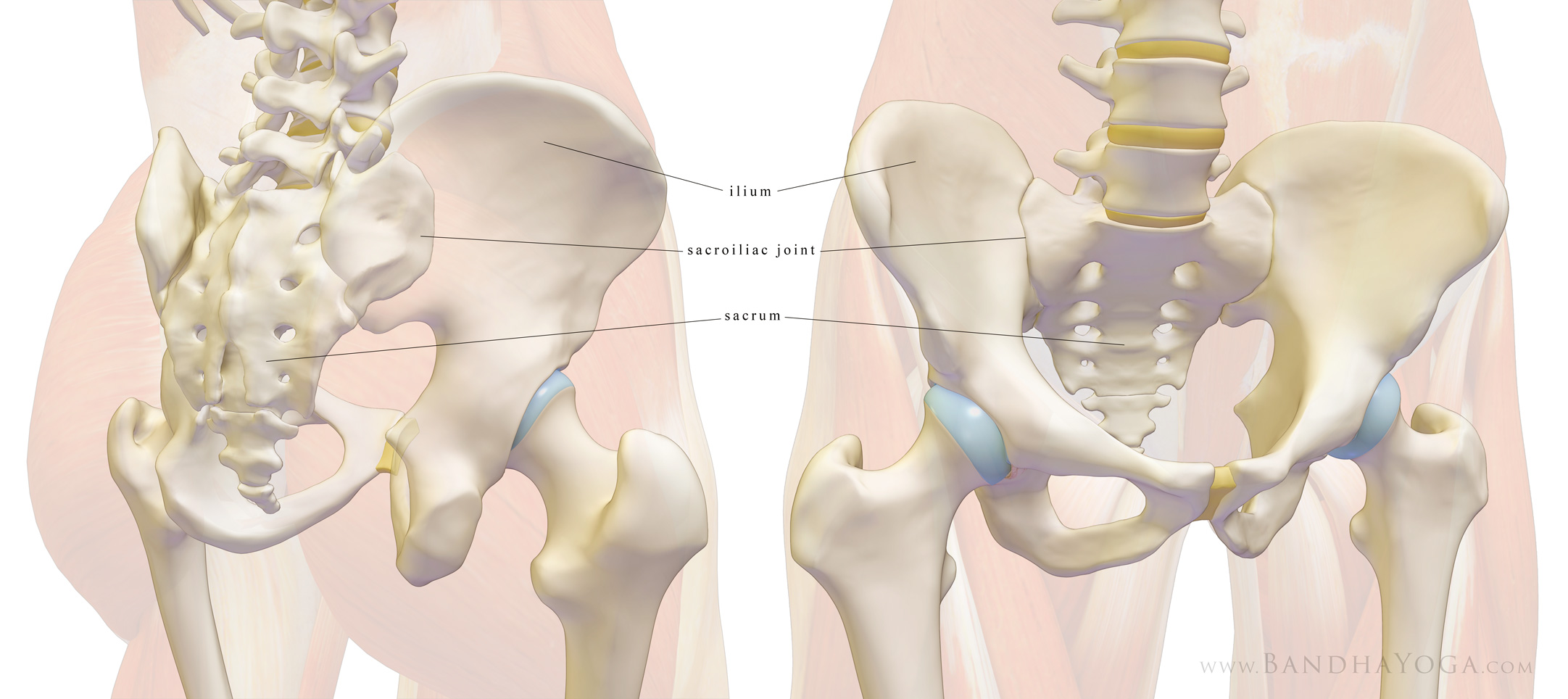 |
| Figure 1: The bones of the sacroiliac joint. |
Figure 2 illustrates the stout ligamentous stabilizers of the joint. These include:
- The anterior (front) and posterior (back) sacroiliac ligaments running from the sacrum to the ilium;
- The sacrotuberous ligaments running from the sacrum to the ischial tuberosity;
- The sacrospinous ligaments running from the sacrum to the posterior iliac spine;
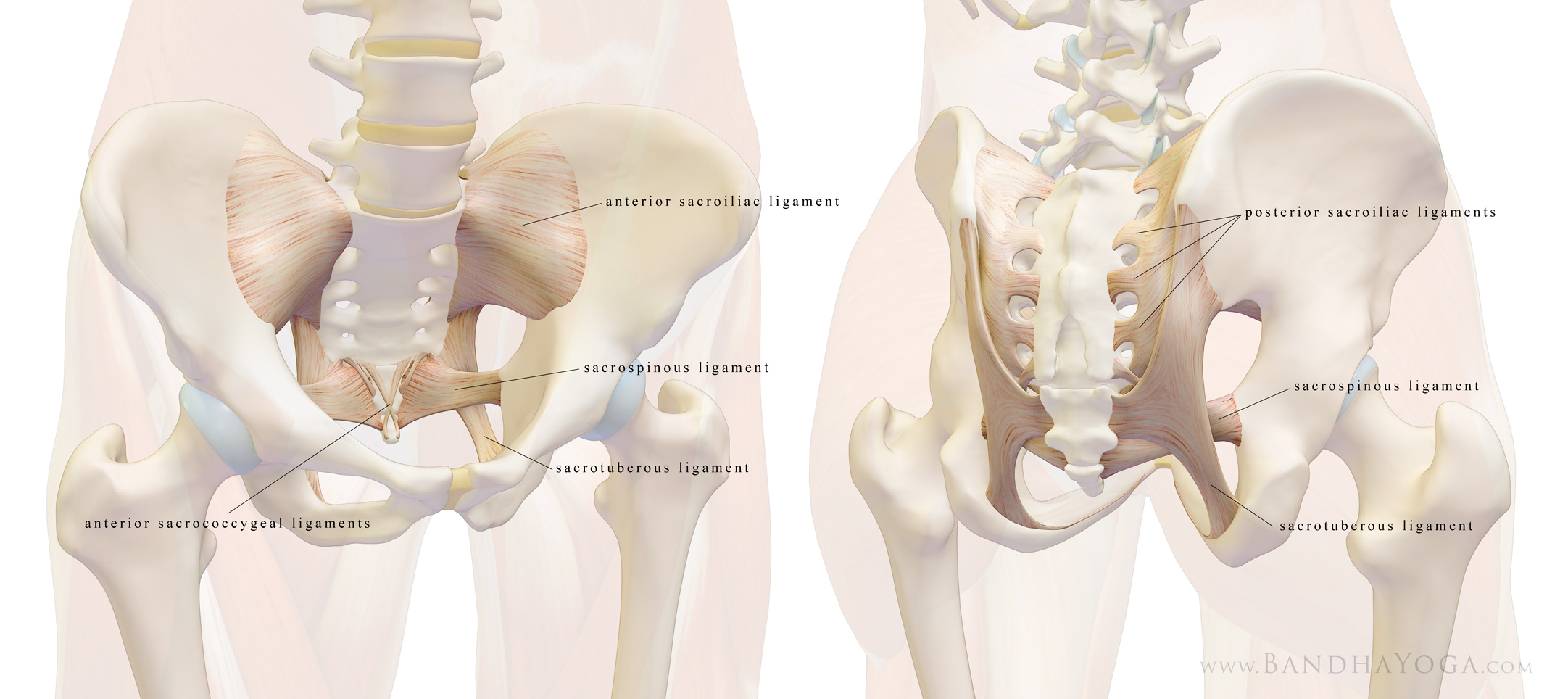 |
| Figure 2: The ligaments of the sacroiliac joint. |
Movement is very limited for this joint, but includes nutation or anterior tilt (flexion) of the sacrum between the ilia, counter-nutation or posterior tilt (extension) and small movements of the ilia themselves. The stable SI joint thus functions for shock absorption and transfer of torque during ambulation.
Muscles and fascia also confer stability to the joint. Figure 3 illustrates the relationship between the erector spinae muscles of the back and the muscles of the pelvic floor. You can see that the erector spinae muscles draw the sacrum into flexion (nutation) and the muscles of the pelvic floor (especially the pubococcygeus) draw the bone into extension (counter-nutation). Simultaneously engaging these muscles creates opposing forces that stabilize the joint.
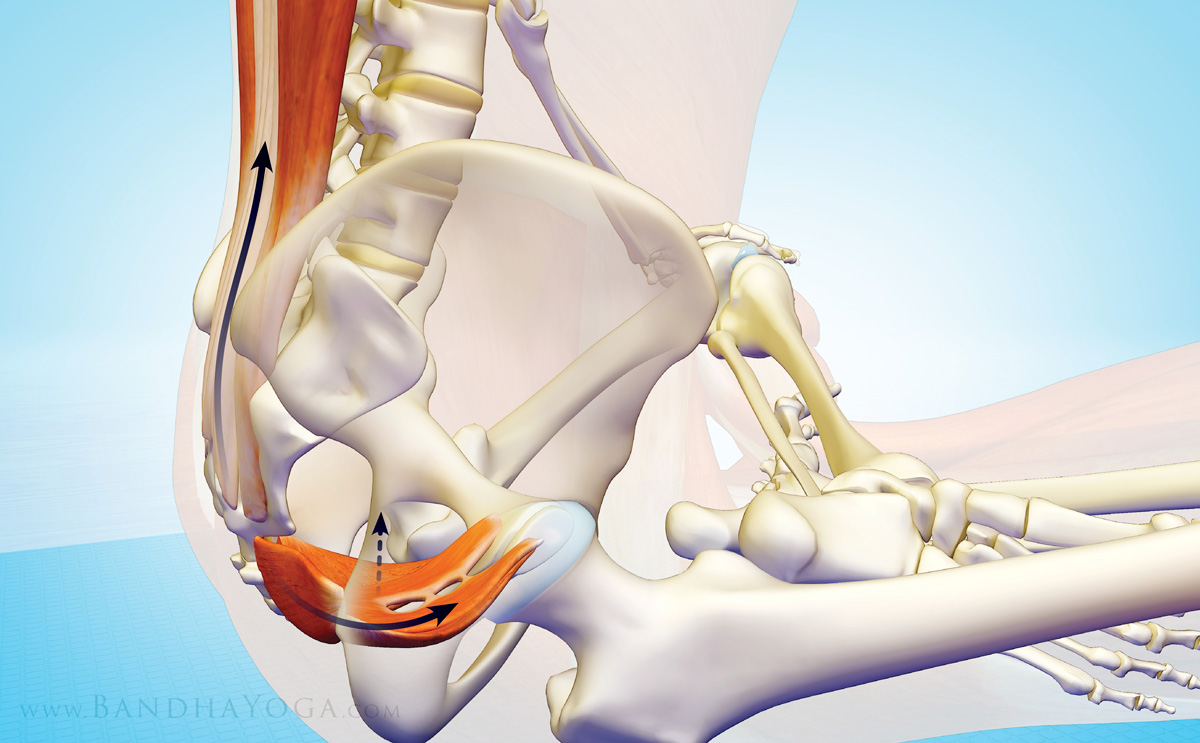 |
| Figure 3: The interaction between the erector spinae and pelvic floor muscles for stabilizing the SI joint. |
Figure 4 illustrates the relationship of the latissimus dorsi and gluteus maximus muscles on opposite sides of the body. In between is the thoracolumbar fascia. Note how the fibers of these structures run perpendicular to the joint. Thus, working with core exercises such as Bird Dog Pose can help to strengthen the dynamic stabilizers of the SI joint. These muscles, along with the fascia comprise the “posterior oblique subsystem”.
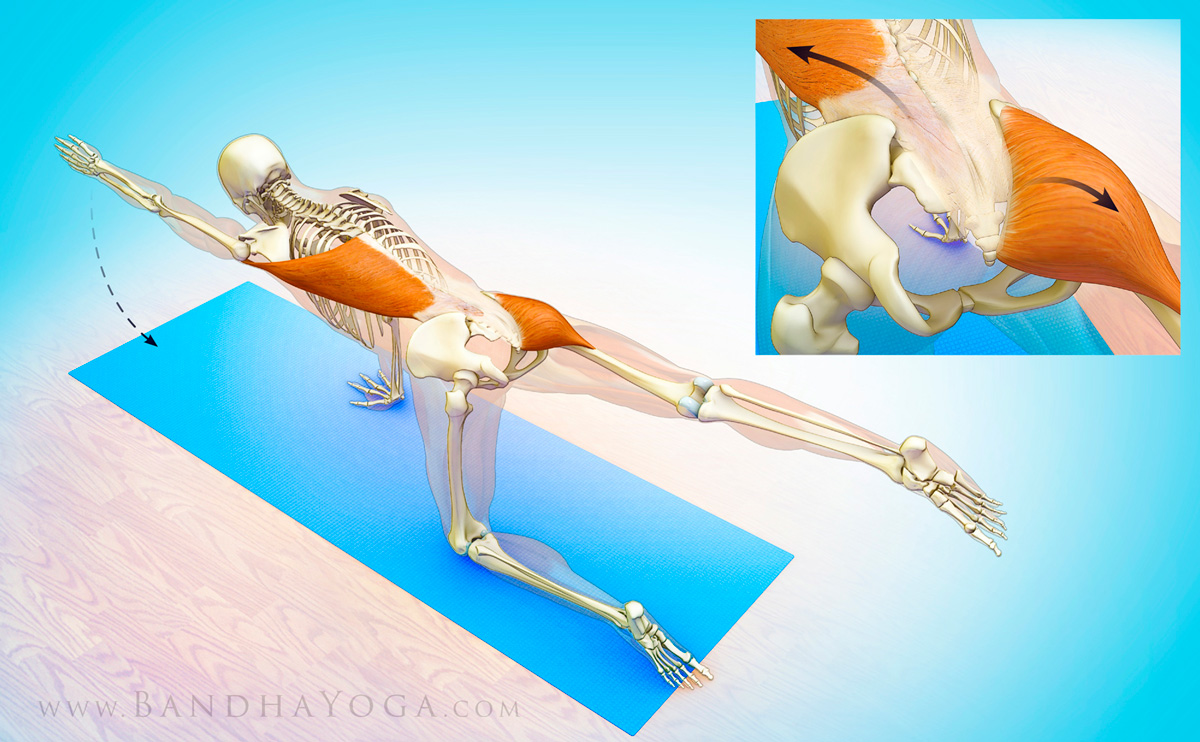 |
| Figure 4: The posterior oblique subsystem for stabilizing the SI joint. |
Want to learn more about anatomy and biomechanics for your practice? Click here to check out the Yoga Mat Companion series! Below are some excerpts from these books.
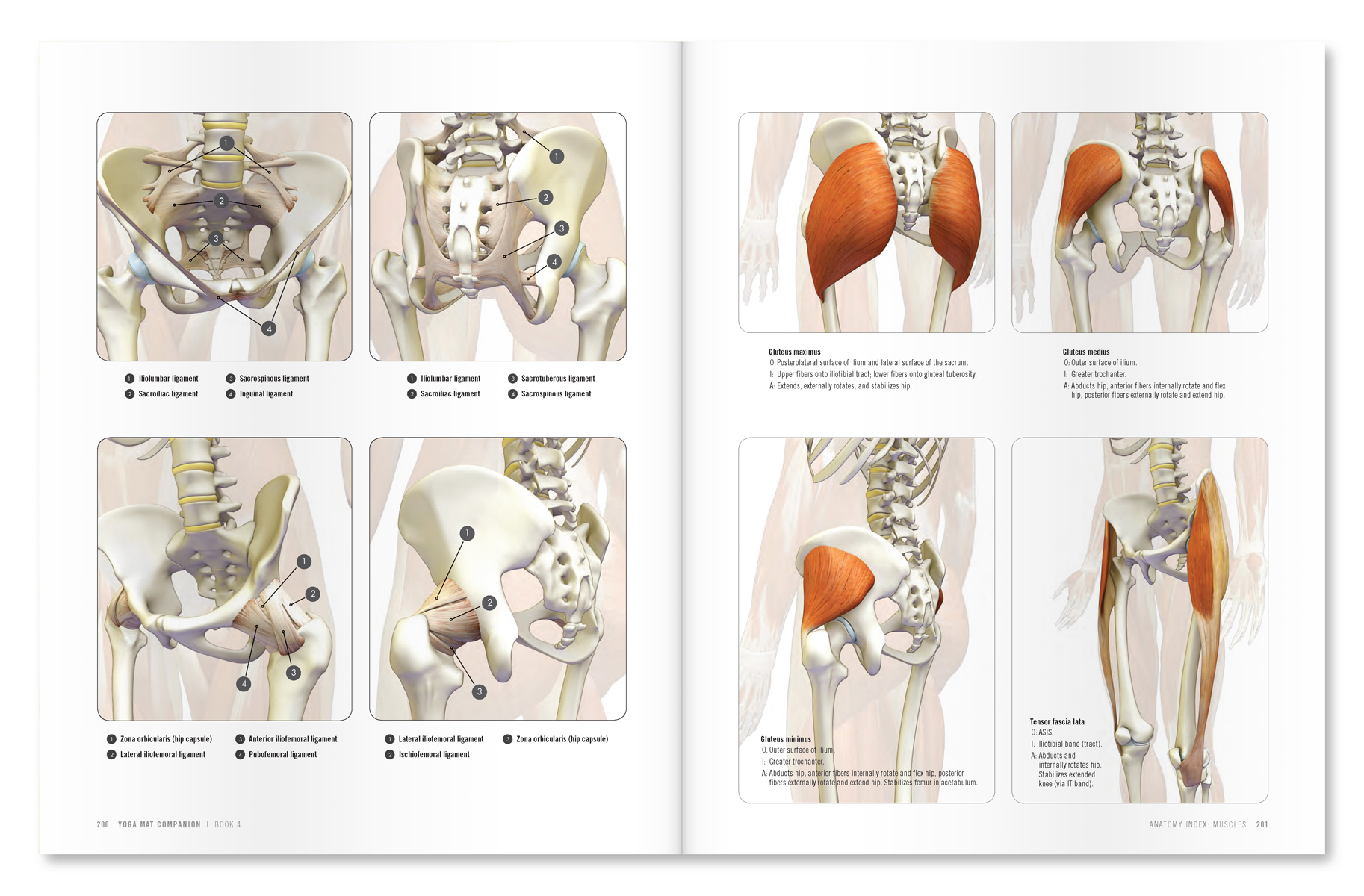 |
| An excerpt from "Yoga Mat Companion 4 - Anatomy for Arm Balances and Inversions". |
 |
| An excerpt from "Yoga Mat Companion 3 - Anatomy for Backbends and Twists". |
Hope you enjoy this overview of the foundational structures of the SI joint. I’d also like to say to our friends in Florida that I'll be teaching in beautiful Tampa/St Pete on the weekend of September 23--25. This is a special intensive in which I will be presenting the most recent research on stretching biomechanics and physiology in a manner that you can apply to your actual practice. Not to be missed! This intensive is the only course I'll be teaching in the Southeast USA this year--hope to see you there! Click here for more information from Suncoast Yoga Teachers Association…
All the Best,
Ray Long, MD

awesome....thank you!
ReplyDeleteVery helpful, thank you! Are there other poses or exercises I can do to strengthen and support the sacroiliac joint?
ReplyDeleteHi Arielle,
DeleteYes, there are! I am a Physical Therapist & Holistic Health Coach. I would be happy to walk you through some easy assessments & exercises to help you keep aligned properly. I personally know how painful the SI joint can be.
Kristen Koch Glancey
Very helpful! Are there other poses to support and stabilize the sacroiliac joint? Thank you!
ReplyDeleteAs always, of great value...thank you!
ReplyDeleteYour posts are incredibly helpful. Thank you!
ReplyDeleteThanks for the info. I have rheumatoid arthritis, and it has moved into SI joint on the left side. This is helpful information to have.
ReplyDeleteI have been practicing and studying massage therapy for over 15 years, and I have never seen such a splendid, practical and clear explanation of the structure and functions of the SI joint. As a yoga teacher as well, seeing the biomechanics as they relate to asanas is wonderful!!
ReplyDeleteVery good stuff, Ray - much obliged, KB
ReplyDeleteRay- Can you sometime shed some light on ways to keep the pelvic floor toned as a stabilizer for the sacrum?
ReplyDeleteI wish these articles could be pinned
ReplyDeleteThese are some great tips for me to teach my massage clients. Thanks, keep them coming.
ReplyDeleteWhat book would be best for overview of poses to strengthen and stabilize? I have a hip labral tear
ReplyDeleteThank you for the visuals as these are my problem areas.
ReplyDeleteThanks Ray - always informative. Please let me know if you're heading into the Australasia region sometime. Namaste! Rhys
ReplyDeleteGreat thank you! Coming to Australia?
ReplyDeleteyour explanations along with the pictures are really helpful in understanding of the body structure and how to do the correct pose.Thank you
ReplyDeleteNice explanation with anatomical diagrams. Thank you very much Mr.Ray
ReplyDeleteAs a newly certified Yoga teacher this is fascinating. As someone who just tweaked her sacrum, this is priceless! Thank you :) Namaste
ReplyDeleteHi, i really love your posts and helped me a lot! I see improvent by adding the cues.. 😊
ReplyDeleteI wanted to ask a question, i dont know if it will be answered, but i have to try..
The question, does backbending is bad for the health of the back? By backbending you stretch the ligaments, because there are no muscles in front of the spine to stretch? I'm asking because i read this statement on a blog, written by a gymnastics coach..
Im really interested in backbending and i need to know if im doing it wrong!
Thank you!
Hi! I'm a yoga teacher from Chile. I'm pregnant with 6 months and i've been experimented very intense pain in this joint lately, i imagine it's because the ligaments are "lazy" now... Do you have any suggestions, excercises or more info about pregnancy and this joint?
ReplyDeleteThank you very much, i follow every posts and share it with my students.
Abrazos!
During pregnancy a hormone relaxes your ligaments to allow for birth. This can literally be a pain in the ass. Continue with your exercises but make them as gentle and smooth as possible. This will allow the ligaments more tone.
DeleteDetails like these help to intensify the existence of a Creator. I would someone to explain to me how Evolution could achieve these intricate details.
ReplyDeleteHello Again!
ReplyDeleteI am the Prenatal Specialist who teaches other teachers how to teach Prenatal YogaI. know I already gushed over the pelvic floor image you sent before, and you were so kind to offer me a high resolution copy . Just wondering if I could possibly get this one on the sacroilliac joint, as this is the other MOST talked about area in a Pregnant Woman's body during class? I would also like to know when the book comes out showing these images?
Thanks you again
Juliette Kurth
silverlakeyoga.com, RYT 500, 200, PRYT 85 hr.
birthingbutterfly.com(DONA certified)
labortogether.com
Awesome blog posted.
ReplyDeleteBandha Yoga Rocks....thanks Ray Long!
ReplyDeleteDig this stuff. Such wonderful information. Thank you.
ReplyDeleteI'm a 200 RYT and really get a lot out of your blogs and the graphics. In doing Bird Dog, we're using our lats and glutes as well as building our core. Would you maybe blog some on what fascia is? I've dealt with plantar fasciitis and was told to scrape my foot fascia. It's been difficult to heal, but is now better. Thanks!
ReplyDeleteThank you for this article! One thing I don't understand. You don't work latissimus dorsi in Bird Dog Pose in fact, do you?
ReplyDeleteBut the stabilizing role for SI joint of simultaneous work of lat. and Gluteus would be really effective. Which poses are more effective in this perspective?